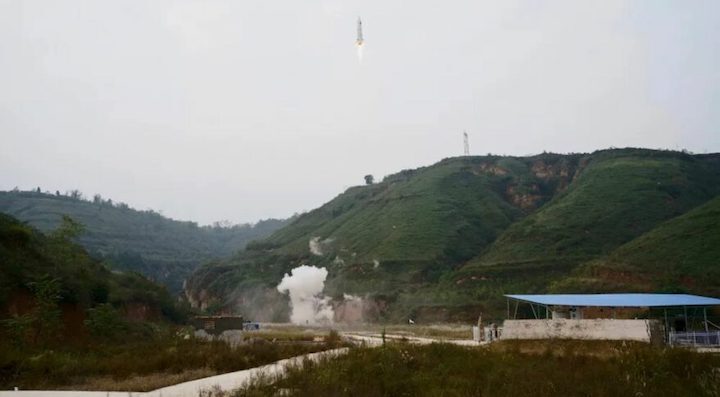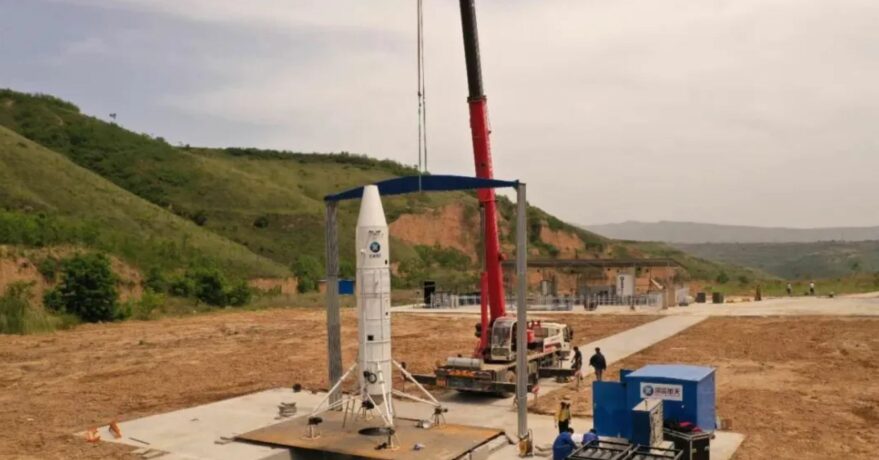1.02.2022

HELSINKI — Commercial space activities have developed rapidly in China in recent years, with major government policy shifts allowing a series of launch startups to emerge and compete for new opportunities.
Deep Blue Aerospace, one of a second wave of companies that followed the first few early entrants, is now pushing to reach orbit with its Nebula-1 rocket in 2023 — while also landing the first stage.
In October at an aerospace test base in Tongchuan, Shaanxi province, Its Nebula-M test stage rose to a height of 103.2 meters above its verdant surroundings before beginning to descend, engine still burning. The variable thrust Leiting-5 electric-pump-fed kerosene-liquid oxygen engine brought the vehicle slowly back to Earth and, despite a bounce and a wobble, the Nebula-M remained upright.
It was a tiny hop by new standards set by SpaceX, trailblazers of reusable orbital launch vehicles, but also a nod as to the direction of the future of China’s commercial launch sector.
In an interview with SpaceNews, Huo Liang, CEO of Deep Blue Aerospace, says he was always interested in aerospace. In primary school he would make model airplanes and also look at the stars, wondering what could be out there in the cosmos. Later, Huo watched the 2003 Shenzhou-5 mission on TV as Yang Liwei became the first Chinese national in space. “I hoped that one day maybe I could work in that industry and get involved in things.”
Huo worked at the China Aerospace Science and Industry Corporation (CASIC), a defense contractor engaged in space activities. In 2016 he left CASIC to enter the commercial space sector, after China allowed private capital into portions of the space sector in 2014 and upgraded “military-civil fusion” to a national strategy, which helps facilitate the transfer of restricted technologies.
He joined OneSpace, a launch company aiming to make low-cost, reliable commercial solid rockets, but then changed direction, establishing Beijing Deep Blue Aerospace Technology Co., Ltd., in 2017, which is headquartered in Nantong City near the mouth of the Yangtze River.

Deep Blue Aerospace have not followed the route taken by other Chinese companies of first developing and launching a solid launch vehicle, like Landspace, iSpace and Galactic Energy. The success of the SpaceX Falcon 9 was an inspiration for the direction Deep Blue Aerospace have taken.
“Our goal is to develop new kinds of launch vehicles to reach space. So, we are developing reusable rockets and so these must be liquid rockets,” Huo stressed.
“Reusable liquid rockets like those from SpaceX have already changed the launch market completely and demonstrated that space can be accessed much more efficiently and much cheaper,” Huo explains. “Therefore, we don’t think we need to use time and money on the aspects like solid propellant rockets, it’s not our goal.”
Along with a reusable first stage, DBA are also 3D printing engine components to bring down costs. The techniques, technologies and processes for these have been challenging, especially under the time pressure brought by a crowded field of fellow entrants into China’s commercial launch sector.
Launch and landing tests
The company took two small steps towards the planned Nebula-1 reusable orbital rocket in the second half of 2021, conducting first a successful 10-meter and then the 100-meter-level vertical takeoff, vertical landing tests with the Nebula M1 test stage.
“Technically, it is not a very big achievement compared to orbital recovery. That’s the height above the Karman Line recovery. But it is indeed the first step for a Chinese company and for us to reach that goal. From these tests, we have verified that the technology we chose for achieving vertical takeoff and vertical landing.”
From here, the next test is a kilometer-level test, using the Nebula-M. A larger Nebula-2M test article which will use the Nebula-1’s Leiting-20, 20-ton-thrust kerolox engine, would be used for 100-kilometer-level tests. “Our plan is to produce the Nebula-1 liquid rocket orbital launcher as early as possible. And we will start orbital recovery simultaneously.”
Deep Blue Aerospace currently employs nearly 100 people, with some coming from China’s traditional space industry institutes and companies, and some from areas such as the automobile and aviation industries. Around 70 percent of the team are engineers.
Chinese authorities provided a sum of money to help companies get going, and Huo notes that the “national team” or state-owned space players, and agencies have been open and inclusive towards new commercial players. Yet, Huo says, “we operate separately, we make our own plans, and implement different kinds of measures and things to provide different services to our customers.”
Satellite internet, space station and commercial opportunities
On Jan. 18 the company secured nearly $31.5 million in funding with investors including Zhencheng Capital, DT Capital and Galaxy capital.
“The main opportunities for us and other competitors in this area are the rapid growth of the satellite launch market in China and the policy and finance support from government and private investment.
“I think if commercial rocket companies like us can prove that we can provide reliable and cost effective launch services, then the national satellite Internet project and even the space station program will be our customers.”
In 2021 China established a new state-owned company to oversee a national Satellite Internet project that, according to filings with the International Telecommunication Union (ITU) in 2020, plans to construct low Earth orbit constellations totaling 12,992 satellites.
In January 2021 a call for proposals was issued by China’s human spaceflight agency, CMSA, soliciting low-cost cargo transportation solutions for the Chinese space station, apparently signaling that commercial actors can get involved in the project in the future, in a similar fashion to NASA’s commercial cargo program.
Regulations and frameworks have been formulated to provide guidance in areas including commercial launch vehicles and small satellites.
The competition
Progress is clearly being made by Deep Blue. The company has earned support and opportunities appear present. Yet there is competition.
Other Chinese startups are developing rockets with reusable first stages. A 2019 test by Linkspace reached an altitude of 300 meters with a small rocket using ethanol and liquid oxygen propellant engines. After a lengthy apparent hiatus, the firm is once again active and targeting its own, 100-kilometer-altitude launch and landing test by the end of the year.
Space Pioneer and iSpace are preparing their own hop tests using the Tiansuo-1 and a Hyperbola-2 first stage test vehicles respectively. Landspace is meanwhile planning to upgrade its Zhuque-2 methalox orbital launcher for reusability following its first launch which is expected as soon as the first quarter of 2022. A new launch complex to handle commercial liquid launch vehicles has been constructed at the national Jiuquan Satellite Launch Center.
Galactic Energy, which has twice reached orbit with its Ceres-1 solid rocket, are also developing a VTVL-capable liquid rocket, Pallas-1, targeting launch around early 2023. Orienspace emerged last year and has already raised around $110 million.
Spinoffs from state-owned entities CASC, CASIC and the Chinese Academy of Sciences are developing solid and liquid propellant rockets for commercial markets.
Towards full reusability?
“Nowadays there are several rocket companies in China, and we all make different kinds of vehicles. At Deep Blue Aerospace, we want to develop only rockets, and go from partially reusable and extend to fully reusable vehicles. And we launched to do something special and have different kinds of operational measures and culture.
“The second stage could be made reusable, like a space shuttle. That could dramatically reduce the cost of the vehicle to enter space and return to Earth. That we will be our dream,” says Huo.
Huo also believes the choice of RP-1 fuel over methane brings advantages, such as being easy to handle and being cheaper. A price per kilogram to orbit was not offered, as this will only become apparent following development of Nebula-1. Prices of around $5,000 per kilogram have circulated in Chinese press reports.
The factories for engines and rockets are located in the south of China in Jiangsu Province, in a place named Nantong city, very near to Shanghai. The area is beside the Yangtze and very near the coast. So, after we have built our rockets, they can be transported to the launchpad by ships.”
With some of the infrastructure in place and work on Nebula-1 ahead, plans for the future are emerging. In November firm unveiled a concept for the Nebula-1H, a three-core rocket which would apparently take a similar approach to SpaceX in its development of the Falcon Heavy from the Falcon 9.
“After we have the ability to launch satellites we will think about other areas. That means not only satellites, but other missions, such as exploration, and in the future, even human spaceflight missions in the future. But not yet.”
China’s space ecosystem is somewhat closed off from the rest of the world, for internal and external reasons. But Deep Blue Aerospace and other companies in China will also be looking abroad.
“China’s private commercial sector is still in its infancy, we are very pleased to cooperate with various regions and peoples and nations.
“The global space market is rapidly growing and we think we can be one of the launch service providers on the global market,” Huo concludes.
Quelle: SN

